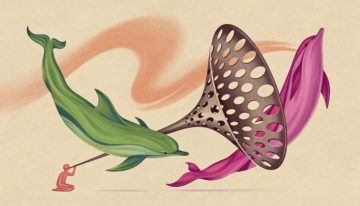Philip Ball in The New Yorker:
 Disney’s 2019 remake of its 1994 classic “The Lion King” was a box-office success, grossing more than one and a half billion dollars. But it was also, in some ways, a failed experiment. The film’s photo-realistic, computer-generated animals spoke with the rich, complex voices of actors such as Donald Glover and Chiwetel Ejiofor—and many viewers found it hard to reconcile the complex intonations of those voices with the feline gazes on the screen. In giving such persuasively nonhuman animals human personalities and thoughts, the film created a kind of cognitive dissonance. It had been easier to imagine the interiority of the stylized beasts in the original film. Disney’s filmmakers had stumbled onto an issue that has long fascinated philosophers and zoologists: the gap between animal minds and our own. The dream of bridging that divide, perhaps by speaking with and understanding animals, goes back to antiquity. Solomon was said to have possessed a ring that gave him the power to converse with beasts—a legend that furnished the title of the ethologist Konrad Lorenz’s pioneering book on animal psychology, “King Solomon’s Ring,” from 1949. Many animal lovers look upon the prospect of such communication with hope: they think that, if only we could converse with other creatures, we might be inspired to protect and conserve them properly. But others warn that, whenever we attempt to communicate with animals, we risk projecting our ideas and preconceptions onto them. We might do this simply through the act of translation: any human language constrains the repertoire of things that can be said, or perhaps even thought, for those using it.
Disney’s 2019 remake of its 1994 classic “The Lion King” was a box-office success, grossing more than one and a half billion dollars. But it was also, in some ways, a failed experiment. The film’s photo-realistic, computer-generated animals spoke with the rich, complex voices of actors such as Donald Glover and Chiwetel Ejiofor—and many viewers found it hard to reconcile the complex intonations of those voices with the feline gazes on the screen. In giving such persuasively nonhuman animals human personalities and thoughts, the film created a kind of cognitive dissonance. It had been easier to imagine the interiority of the stylized beasts in the original film. Disney’s filmmakers had stumbled onto an issue that has long fascinated philosophers and zoologists: the gap between animal minds and our own. The dream of bridging that divide, perhaps by speaking with and understanding animals, goes back to antiquity. Solomon was said to have possessed a ring that gave him the power to converse with beasts—a legend that furnished the title of the ethologist Konrad Lorenz’s pioneering book on animal psychology, “King Solomon’s Ring,” from 1949. Many animal lovers look upon the prospect of such communication with hope: they think that, if only we could converse with other creatures, we might be inspired to protect and conserve them properly. But others warn that, whenever we attempt to communicate with animals, we risk projecting our ideas and preconceptions onto them. We might do this simply through the act of translation: any human language constrains the repertoire of things that can be said, or perhaps even thought, for those using it.
In 1974, the philosopher Thomas Nagel published a seminal paper called “What Is It Like to Be a Bat?” Bat life, Nagel argued, is so profoundly different from human life that we can never truly know the answer to that question. Our understandings are shaped by our human concepts; the only way to know what it is like to be a bat is to be a bat, and to have bat concepts. Even if we don’t or can’t know exactly what it’s like to be a bat, we can have some understanding of how bat minds work; we can understand that bat life is lived aloft, sometimes upside down, and partly through echolocation. Still, in Nagel’s view, something is left out: the experience itself. As the philosopher Ludwig Wittgenstein famously put it, if a lion could talk, we could not understand him—our human minds would not share the sensory and conceptual landscape that lion-talk would express.
More here.
